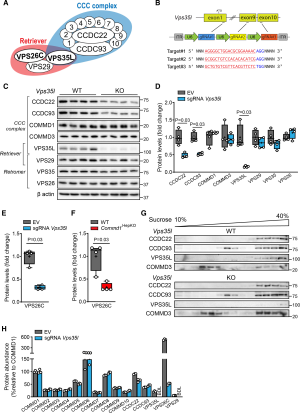
New Key Publication: Cargo-Specific Role for Retriever Subunit VPS26C in Hepatocyte Lipoprotein Receptor Recycling to Control Postprandial Triglyceride-Rich Lipoproteins

Abstract
Background: The coiled-coil domain containing 22/coiled-coil domain containing 93/copper metabolism MURR1 domains (CCC) complex is required for the transport of low-density lipoprotein receptor (LDLR) and LRP1 (LDLR-related protein 1) from endosomes to the cell surface of hepatocytes. Impaired functioning of hepatocytic CCC causes hypercholesterolemia in mice, dogs, and humans. Retriever, a protein complex consisting of subunits VPS26C, VPS35L, and VPS29, is associated with CCC, but its role in endosomal lipoprotein receptor transport is unclear. We here investigated the contribution of retriever to hepatocytic lipoprotein receptor recycling and plasma lipids regulation.
Methods: Using somatic CRISPR/Cas9 gene editing, we generated liver-specific VPS35L or VPS26C-deficient mice. We determined total and surface levels of LDLR and LRP1 and plasma lipids. In addition, we studied the protein levels and composition of CCC and retriever.
Results: Hepatocyte VPS35L deficiency reduced VPS26C levels but had minimal impact on CCC composition. VPS35L deletion decreased hepatocytic surface expression of LDLR and LRP1, accompanied by a 21% increase in plasma cholesterol levels. Hepatic VPS26C ablation affected neither levels of VPS35L and CCC subunits, nor plasma lipid concentrations. However, VPS26C deficiency increased hepatic LDLR protein levels by 2-fold, probably compensating for reduced LRP1 functioning, as we showed in VPS26C-deficient hepatoma cells. Upon PCSK9 (proprotein convertase subtilisin/kexin type 9)-mediated LDLR elimination, VPS26C ablation delayed postprandial triglyceride clearance and increased plasma TG levels by 26%.
Conclusions: Our study suggests that VPS35L is shared between retriever and CCC to facilitate LDLR and LRP1 transport from endosomes to the cell surface. Conversely, retriever subunit VPS26C selectively transports LRP1, but not LDLR, and thereby may control hepatic uptake of postprandial TG-rich lipoprotein remnants.
Authors:
- Dyonne Y Vos
- Melinde Wijers
- Marieke Smit
- Nicolette Huijkman
- Niels J Kloosterhuis
- Justina C Wolters
- Joël J Tissink
- Amanda C M Pronk
- Sander Kooijman
- Patrick C N Rensen
- Jan Albert Kuivenhoven
- Bart van de Sluis
Read more : Arterioscler Thromb Vasc Biol . 2022 Nov 10. doi: 10.1161/ATVBAHA.122.318169: https://www.ahajournals.org/doi/10.1161/ATVBAHA.122.318169
More news
-
15 September 2025
Successful visit to the UG by Rector of Institut Teknologi Bandung
